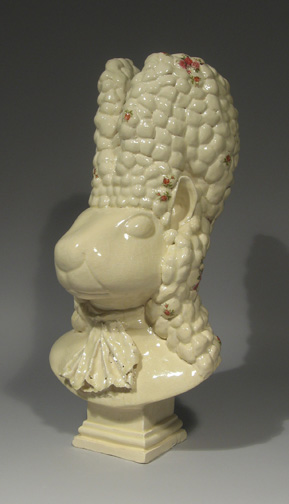
Squirrel Busts
One of the most favorable ways to grab a person’s attention is through a surprising element of humor. Seeing something that appears rather odd causes the brain to pause for an instant and want to investigate the object more closely. That is my initial reason for using the squirrels in my current work. These particular animals are easily referenced by nearly everyone, and they also have a feisty attitude and a sense of absurdity that nearly everyone can relate to, either finding it cute and charming or incredibly irritating. Either way, giving these creatures a human personality creates a humor that makes the viewer curious about the sculptures.
Most people do not realize how broad the medium of ceramics actually is – it has a deep history, dating back thousands and thousands of years, and as a scholar I have tried to investigate a range of finishing techniques from European and American ceramic traditions. Each of these pieces is therefore my own interpretation of an historical ceramics genre that go along with each personality the squirrels represent, and as another tool used to access cultural associations within the viewer.
In this body of work, I have taken many of our cultural associations with squirrels and ceramics and juxtaposed them with an historical concept that literally puts them on a pedestal. The historical role of the portrait bust has been to monumentalize the figures that are represented. Its roots begin with the Greek tradition of depicting idealized figures, and then elaborated by the Romans who introduced realistic portrayals of the emperors as propaganda. The genre has continued into American honorary statues where the halls of governmental buildings are lined with these tributes to our heroic leaders. Capturing people in such a permanent form immortalizes them, their ideas, and the ideals that they represent will be carried on to the next generations. But what are these ideals? The Greek statues were of the superlative people that never existed; the American presidents represent the free democratic society that uses stereotypes and prejudice to exploit and control other cultures within its borders and without. Seen in this light, these ideals seem a bit ridiculous to be monumentalized. When the squirrels are placed in this honorific tradition, glossed, lustered and stone-like, they are intended to recall the viewers’ ideas of absurdity and question the ideals of human culture that civilizations have been putting on pedestals for thousands of years.

Current Drawings
While it may not seem so at times, all architectural elements are designed to support the structure of the individual’s way of life, making it efficient, convenient, and usually even pleasing to look at. The modern architecture of a metropolitan city is an environment where the sheer size of the buildings literally shadows the individual and makes him even smaller in the crowds on the street. The design of walkways and tunnels directs his very steps to where he’s supposed to go. In my current drawings, I employ a collage of images of modern urban architecture that have been removed several times from their original state. They go from their real existence as freestanding architecture, to being captured on a camera, altered on the computer, and then transferred onto a new two-dimensional composition. I complete the process by finally drawing over top with black marker to emphasize and stylize certain parts of the buildings and structures, ultimately creating a new environment of my own that has only vague references to a sensible reality. Ultimately the reality of architectural structure and the role it plays in directing an individual through the world has been dismantled and reassembled into a new experience that is curious, full of motion, and confusing.
I have also come to realize that identity is a key element in urban architecture. A city has an identity, but how is it defined – through its types of buildings and their design, its art and monuments, or its citizens and their social history? All of these, and more, are a part of a city’s identity, but since life in a city often becomes confusing, relationships may become blurred and identities can get fuzzy. The hazy nature of the transferred images refers to a sort of loss in the identity that the buildings were created to hold. The towering executive structures have become commonplace, and a person in the streets will hardly look up at them to partake in the awe that they were built to inspire. So, does this mean that we have lost interest in the virtues (strength, power, and achievement) that founded our social structures? I have now employed a secondary structure within the drawing with several borders that break up the composition. They refer to a secondary identity that could exist with any person in the streets drawn – perhaps it is even their own.
